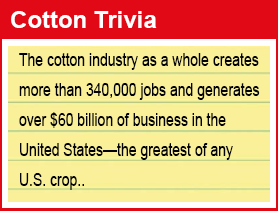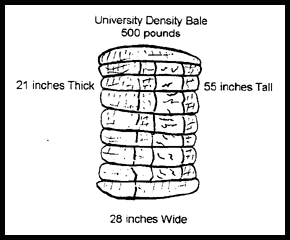The Story of Cotton – Processing the Crop
The cotton gin is where cotton fiber is separated from the cotton seed. The first step in the ginning process is when the cotton is vacuumed into tubes that carry it to a dryer to reduce moisture and improve the fiber quality. Then it runs through cleaning equipment to remove leaf trash, sticks and other foreign matter.
 Ginning is accomplished by one of two methods. Cotton varieties with shorter staple or fiber length are ginned with saw gins. This process involves the use of circular saws that grip the fibers and pull them through narrow slots.
Ginning is accomplished by one of two methods. Cotton varieties with shorter staple or fiber length are ginned with saw gins. This process involves the use of circular saws that grip the fibers and pull them through narrow slots.
The seeds are too large to pass through these openings, resulting in the fibers being pulled away from the seed. Long fiber cottons must be ginned in a roller gin because saw gins can damage their delicate fibers. The roller gin was invented in India centuries ago and this concept is still used in modern gins. Long staple cottons, like Pima, separate from the seed more easily than Upland varietie. A roller gin uses a rough roller to grab the fiber and pull it under a rotating bar with gaps too small for the seed to pass.
 The raw fiber, now called lint, makes its way through another series of pipes to a press where it is compressed into bales (lint packaged for market), banded with eight steel straps, sampled for classing, wrapped for protection then loaded onto trucks for shipment to storage yards, textile mills and foreign countries. The cotton industry has adopted a standard for a bale of cotton, 55 inches tall, 28 inches wide, and 21 inches thick, weighing approximately 500 pounds. A bale meeting these requirements is called a universal density bale. This is enough cotton to make 325 pairs of denim jeans.
The raw fiber, now called lint, makes its way through another series of pipes to a press where it is compressed into bales (lint packaged for market), banded with eight steel straps, sampled for classing, wrapped for protection then loaded onto trucks for shipment to storage yards, textile mills and foreign countries. The cotton industry has adopted a standard for a bale of cotton, 55 inches tall, 28 inches wide, and 21 inches thick, weighing approximately 500 pounds. A bale meeting these requirements is called a universal density bale. This is enough cotton to make 325 pairs of denim jeans.
Every bale of cotton is classed from a sample taken after its formation. The classing of cotton lint is the process of measuring fiber characteristics against a set of standards (grades). Classing is done by experts, called classers, who use scientific instruments to judge the samples of lint. All standards are established by the U.S. Department of Agriculture. Once the quality of the cotton bale is determined, pricing parameters are set and the lint may be taken to market. Cotton marketing is the selling and buying of cotton lint. Cotton is priced in cents per pound when sold and the price is negotiated according to the cotton’s quality. After baling, the cotton lint is hauled to either storage yards, textile mills, or shipped to foreign countries. The cotton seed is delivered to a seed storage area. Where it will remain until it is loaded into trucks and transported to a cottonseed oil mill or directly for livestock feed.
 We have done all the research for you…gathered supplemental literature books, videos and CD’s, and offer a variety of resources to be used in conjunction with your study unit. So let’s get started on our cotton’s journey and learn more about this useful, resourceful and magical plant we take for granted…COTTON!
We have done all the research for you…gathered supplemental literature books, videos and CD’s, and offer a variety of resources to be used in conjunction with your study unit. So let’s get started on our cotton’s journey and learn more about this useful, resourceful and magical plant we take for granted…COTTON! ![]()

